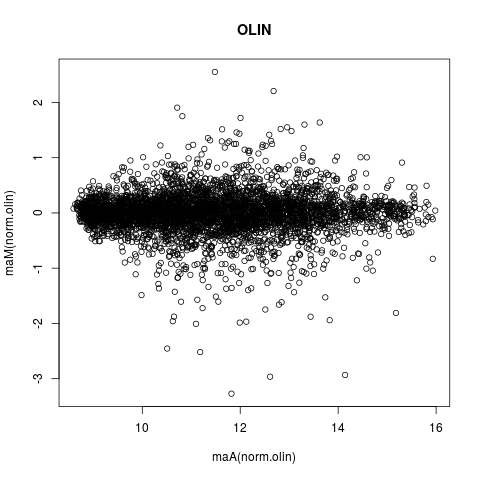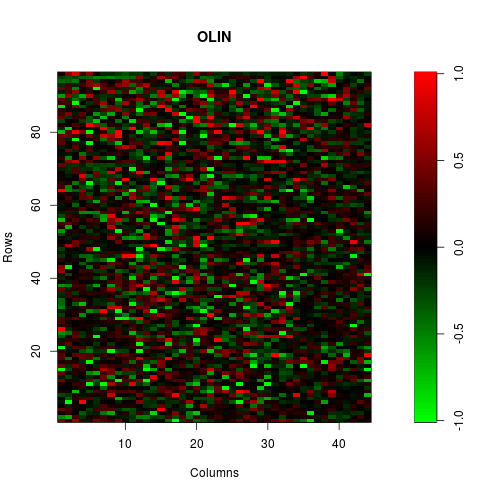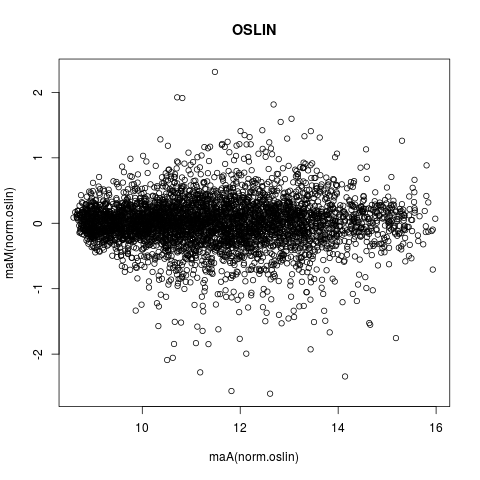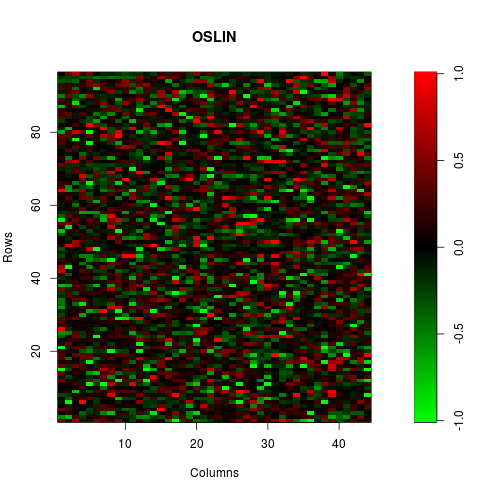Supported by Dr. Osamu Ogasawara and  providing providing  . . |
|
Last data update: 2014.03.03 |
Optimised local intensity-dependent normalisation of two-colour microarraysDescriptionThis functions performs optimised local intensity-dependent normalisation (OLIN) and optimised scaled intensity-dependent normalisation (OSLIN). Usageolin(object,X=NA,Y=NA,alpha=seq(0.1,1,0.1),iter=3,
scale=c(0.05,0.1,0.5,1,2,10,20),OSLIN=FALSE,weights=NA,
genepix=FALSE,bg.corr="subtract",...)
Arguments
DetailsOLIN and OSLIN are based on iterative local regression and incorporate optimisation of model parameters.
Local regression is performed using LOCFIT, which requires the user to choose a specific smoothing parameter Detailed information about OLIN and OSLIN can be found in the package documentation and in the reference stated below.
The weights argument specifies the influence of the single spots on the local regression. To exclude
spots being used for the local regression (such as control spots), set their corresponding weight to zero.
Note that OLIN and OSLIN
are based on the assumptions that most genes are not differentially expressed (or up- and down-regulation
is balanced) and that genes are randomly spotted across the array. If these assumptions are not valid, local
regression can lead to an underestimation of differential expression. OSLIN is especially sensitive to violations of these assumptions. However, this
sensitivity can be decreased if the minimal If the normalisation should be based on set of genes assumed to be not differentially expressed (house-keeping genes), weights can be used for local regression. In this case, all weights are set to zero except for the house-keeping genes for which weights are set to one. In order to achieve a reliable regression, it is important, however, that there is a sufficient number of house-keeping genes that are distributed over the whole expression range and spotted accross the whole array. It is also important to note that OLIN/OSLIN is fairly efficient in removing intensity- and spatial-dependent dye bias, so that normalised data will look quite “good” after normalisation independently of the true underlying data quality. Normalisation by local regression assumes smoothness of bias. Therefore, localised artifacts such as scratches, edge effects or bubbles should be avoided. Spots of these areas should be flagged (before normalisation is applied) to ensure data integrity. To stringently detect artifacts, the OLIN functions ValueObject of class “marrayNorm” with normalised logged ratios Author(s)Matthias E. Futschik (http://itb.biologie.hu-berlin.de/~futschik) References
See Also
Examples
# LOADING DATA
data(sw)
data(sw.xy)
# OPTIMISED LOCAL INTENSITY-DEPENDENT NORMALISATION OF FIRST ARRAY
norm.olin <- olin(sw[,1],X=sw.xy$X[,1],Y=sw.xy$Y[,1])
# MA-PLOT OF NORMALISATION RESULTS OF FIRST ARRAY
plot(maA(norm.olin),maM(norm.olin),main="OLIN")
# CORRESPONDING MXY-PLOT
mxy.plot(maM(norm.olin)[,1],Ngc=maNgc(norm.olin),Ngr=maNgr(norm.olin),
Nsc=maNsc(norm.olin),Nsr=maNsr(norm.olin),main="OLIN")
# OPTIMISED SCALED LOCAL INTENSITY-DEPENDENT NORMALISATION
norm.oslin <- olin(sw[,1],X=sw.xy$X[,1],Y=sw.xy$Y[,1],OSLIN=TRUE)
# MA-PLOT
plot(maA(norm.oslin),maM(norm.oslin),main="OSLIN")
# MXY-PLOT
mxy.plot(maM(norm.oslin)[,1],Ngc=maNgc(norm.oslin),Ngr=maNgr(norm.oslin),
Nsc=maNsc(norm.oslin),Nsr=maNsr(norm.oslin),main="OSLIN")
Results
R version 3.3.1 (2016-06-21) -- "Bug in Your Hair"
Copyright (C) 2016 The R Foundation for Statistical Computing
Platform: x86_64-pc-linux-gnu (64-bit)
R is free software and comes with ABSOLUTELY NO WARRANTY.
You are welcome to redistribute it under certain conditions.
Type 'license()' or 'licence()' for distribution details.
R is a collaborative project with many contributors.
Type 'contributors()' for more information and
'citation()' on how to cite R or R packages in publications.
Type 'demo()' for some demos, 'help()' for on-line help, or
'help.start()' for an HTML browser interface to help.
Type 'q()' to quit R.
> library(OLIN)
Loading required package: locfit
locfit 1.5-9.1 2013-03-22
Loading required package: marray
Loading required package: limma
> png(filename="/home/ddbj/snapshot/RGM3/R_BC/result/OLIN/olin.Rd_%03d_medium.png", width=480, height=480)
> ### Name: olin
> ### Title: Optimised local intensity-dependent normalisation of two-colour
> ### microarrays
> ### Aliases: olin
> ### Keywords: utilities regression
>
> ### ** Examples
>
>
>
> # LOADING DATA
> data(sw)
> data(sw.xy)
>
> # OPTIMISED LOCAL INTENSITY-DEPENDENT NORMALISATION OF FIRST ARRAY
> norm.olin <- olin(sw[,1],X=sw.xy$X[,1],Y=sw.xy$Y[,1])
>
> # MA-PLOT OF NORMALISATION RESULTS OF FIRST ARRAY
> plot(maA(norm.olin),maM(norm.olin),main="OLIN")
>
> # CORRESPONDING MXY-PLOT
> mxy.plot(maM(norm.olin)[,1],Ngc=maNgc(norm.olin),Ngr=maNgr(norm.olin),
+ Nsc=maNsc(norm.olin),Nsr=maNsr(norm.olin),main="OLIN")
>
> # OPTIMISED SCALED LOCAL INTENSITY-DEPENDENT NORMALISATION
> norm.oslin <- olin(sw[,1],X=sw.xy$X[,1],Y=sw.xy$Y[,1],OSLIN=TRUE)
> # MA-PLOT
> plot(maA(norm.oslin),maM(norm.oslin),main="OSLIN")
> # MXY-PLOT
> mxy.plot(maM(norm.oslin)[,1],Ngc=maNgc(norm.oslin),Ngr=maNgr(norm.oslin),
+ Nsc=maNsc(norm.oslin),Nsr=maNsr(norm.oslin),main="OSLIN")
>
>
>
>
>
>
> dev.off()
null device
1
>
|



